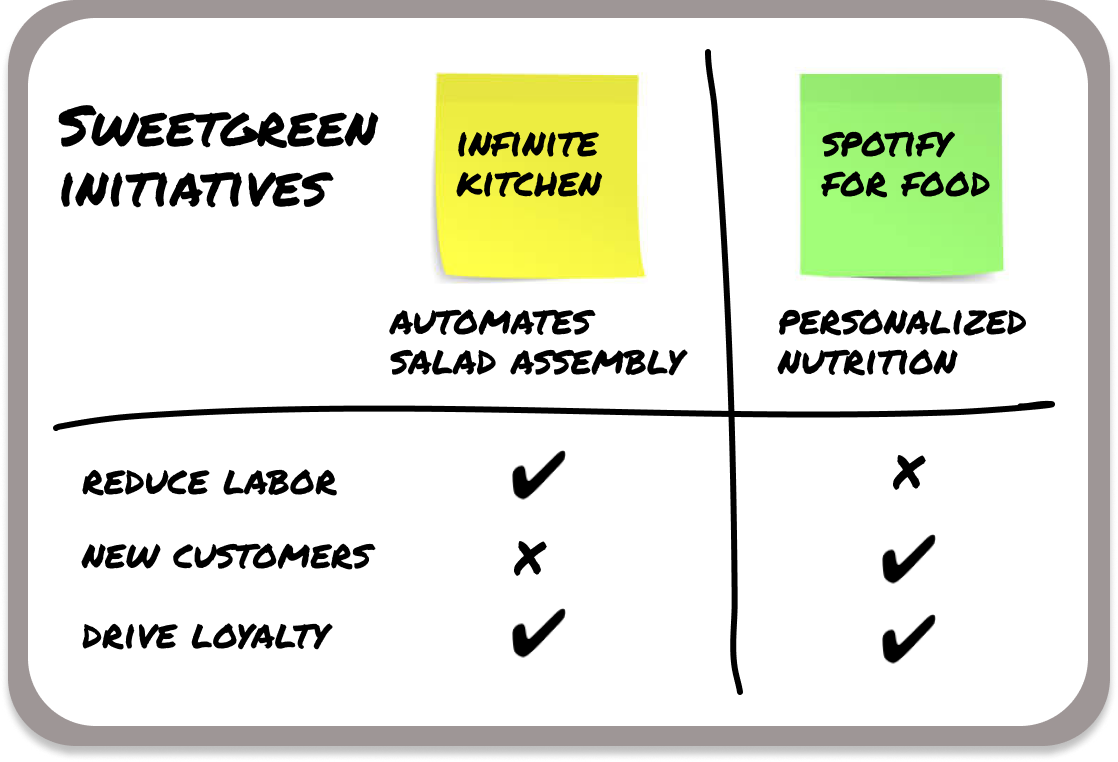The trojan horse of Sweetgreen's Infinite Kitchen
Infinite Kitchen coupled with Spotify for Food will drive demand
A view into Sweetgreen’s Board of Directors meeting 👀
*At least, this is how I imagine the conversation goes.*
Jonathan walks in, pleased with the demo of Infinite Kitchen, Sweetgreen’s in-house tech that automates the assembly of salads and bowls. Think of IK as a series of cylinders that dispense dry ingredients and dressing in your bowl then perfectly tosses it together.
He clicks ‘Slideshow.’
“Infinite Kitchen is positioned as a margin play by decreasing labor. Labor savings outweigh depreciation and maintenance.”
Neil chews on another new Sweetgreen product: a tender piece of 100% grass-fed steak. He likes what he’s hearing.
Jonathan continues: “The trojan horse of Infinite Kitchen is its impact on revenue: by increasing our production capacity by 50%, we can match Shake Shack’s revenue per store.”
Julie nearly chokes on her Sweetgreen Rice Crispy Treat.
“Infinite Kitchen increases supply. Where will the extra demand come from?”
Jonathan smiles, clicks the next slide, and up pops a still frame of the Sweetgreen mobile app.
“Personalized nutrition. What we call ‘Spotify For Food.’ ”
Infinite Kitchen produces 500 bowls per hour, 50% more than today’s capacity.1 Those lines produce 333 bowls combined.
Given Sweetgreen sells ~500 bowls per day,2 Sweetgreen operates at peak demand for ~1 hour, in turn selling 167 bowls across remaining hours.
Considering peak demand rarely meets supply capacity, why not make a smaller, less expensive IK that reduces labor but maintains current throughput?
Maybe there are form factor limitations – in order to automate assembly of ALL meals, IK has to be a certain size and at that size, you get a throughput increase.
My hunch is this: Sweetgreen is betting they can grow demand in their peak hour from 333 to 500 orders, resulting in an increase from $2.9M to $3.9M store sales.3
How does Sweetgreen acquire 167 more customers every. single. day.?
1️⃣ Ingredient / meal evolution4 ✅
2️⃣ Fewer ‘walk-aways’5 ✅
3️⃣ Spotify For Food
Sweetgreen will soon create meals tailored to your health goals, biomarkers, and taste preferences.
Imagine the following integrations:
🅰️ You track meals on MyFitnessPal. You have 530 calories left but need 30g protein, 35g carbs and 10g fat.
You open your Sweetgreen app and boom, a custom dinner rec that fits your goals.
🅱️ Function Health and Edacious.
Your blood test with Function suggests you’re low on Omega 3’s.
Edacious measures nutrient density in food. The steak served in Sweetgreen’s NYC stores has 2x the Omega 3’s compared to grain-fed steak.6
Sweetgreen in turn recommends a meal.
Spotify For Food is outsourced decision making, fitting well into Scott Galloway’s notion that choice is a tax. Consumers don’t want choice, they want to be told what they want.
THE RESULT: new customers and importantly, increased loyalty with heavy users: those eating Sweetgreen 1-2x / week, now 2-4x. All equaling *exactly* 167 more daily orders.
Please let me know what you thought of this newsletter in the comments below!
$2.9M AUV / assumed $16 AOV = 181,250 bowls / 360 days = 503 bowls / day
$2.9M * (1 + 167/500) = $3.9M
Ingredient / meal evolution: 100% grass-fed steak, no seed oils, protein plates, fries\
Walkaway customers are those who intend to buy, but are deterred by long lines. Infinite Kitchen speeds up the line, thereby reducing walkaways
Sweetgreen serves 100% grass-fed steak, which has more Omega 3’s than grain-fed steak






thoughts on the blacklash of the new in app reward system deterring users.... how do you see SG dealing with complaints on serving sizes? Perhaps focus on driving value in personalization as you suggest? Forgoing the demand/profit from the other group of customers and targetting on those loyal and paying for the "personalized touch?"